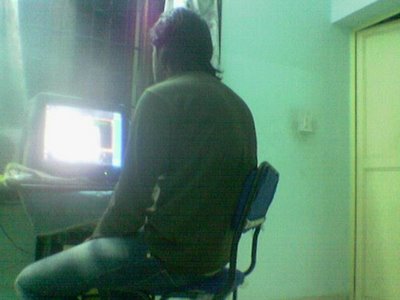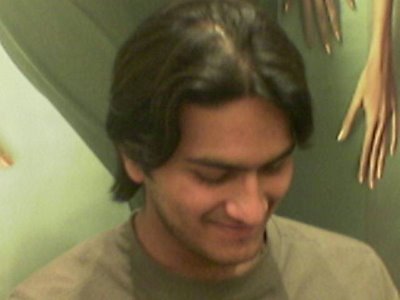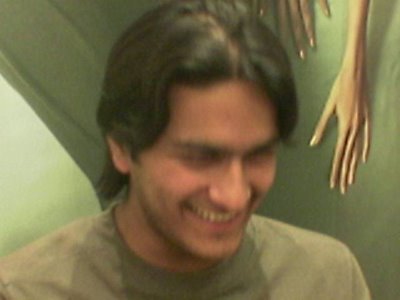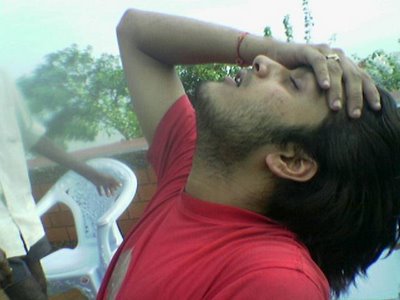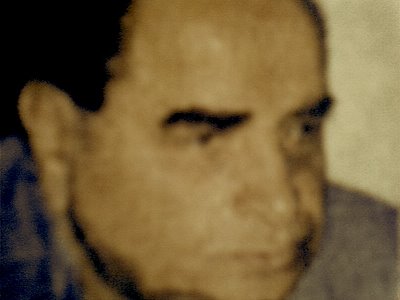
To suggest that ‘an artist is constantly evolving’ is fallacy: in fact, more often than not they keep repeating themselves, and any attempt at reinvention is at best, painfully forced. Any transformation in the artist’s oeuvre, if it does occur- for example, the famous ‘moods’ in Picasso’s prolific repertoire- is assuredly cathartic: this, I believe, accords with the ‘theory of punctuated evolution’, which postulates that status-quo rather than change is Nature’s norm. A cursory glance at Tushar’s present Collection- eight large canvases and an even larger triptych (in the making, at the time of writing this)- in light of his earlier work, alludes not so much to ‘a significant evolution’, as this self-taught artist is wont to believe, as it does to a Rebirth: ergo, any reference to
his artistic antecedents in presenting this Collection, becomes redundant. For me, the 30-year-old Bhilai-based Tushar Waghela is a just-Fallen Adam.
I present this Collection here, because in so many ways, the story of Tushar, the artist and his alter-ego, Adam is also the story of our state: Chhattisgarh.
ADAM'S STORY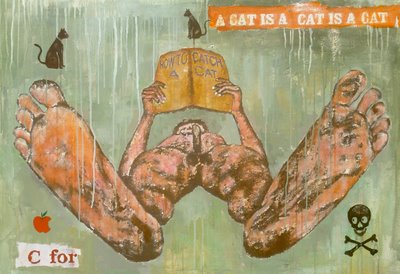 PUSSYCAT CATCHER
PUSSYCAT CATCHER To illustrate: notice, dear viewer, the acrylic on canvas cryptically called ‘Pussycat Catcher’. It’s Adam learning his alphabets, discovering Wittgenstein’s Tractatus, a world where language- the way we communicate- is composed almost entirely of pictures: how to catch a cat? Well, it’s not going to be as easy as our unsuspecting protagonist, blissfully turned-on by the book he is reading, imagines: two Egyptian-kittens lurk above, while a skull-and-crossed-bones insignia, used first by the pirates of yore, is neatly tucked away in a corner, hinting perhaps at impending dangers? The background, still dripping with paint, alludes to a world still in formation; incomplete; wet.
 FURY
FURYThis theme becomes even more pronounced in his next work: Adam is still lying down, but he is no longer reading: the book- now used as a blinder to shield his eyes from a rapidly dissolving sky formed of bold, bloody curls which have come together to form an Angry God looking-down menacingly at him- too is different: it has the word FURY written on its cover. An explanation, however, is offered: the forbidden fruit symbolized as a once-bitten apple persists: Milton’s Paradise Lost suddenly finds its visual allegory in the contemporary Macintosh corporate-logo. It is both a reminder of a history riddled with the shame of banishment, and a precursor of the world to come: a Twilight World dangling between the past and the future; between Heidegger’s Being and Time. Here we evesdrop on Shakespeare's Hamlet muse:
"To be or not to be/ That is the question."
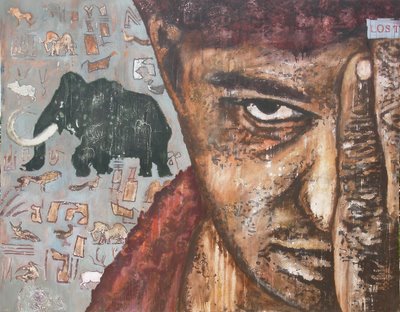 ANCESTORS
ANCESTORS
The break with the past becomes definitive only with ‘Ancestors’. A prehistoric black mammoth dominates a background cluttered with peacocks, jaguars, antlers and proto-hieroglyphics: scenes from a primordial cave, pilfered by irreverent tourists from a nascent civilization. Look closely, and you will see that the mammoth’s surface is scratched: humans have made their sudden, half-baked appearance; they are hunting down the whole herd. In the foreground, Adam, now clothed, gazes intently at us but with only one eye, for his hand still blinds the other. He may indeed be ‘Lost’ but we have made our first eye contact: the dialogue of the eyes has half-begun.
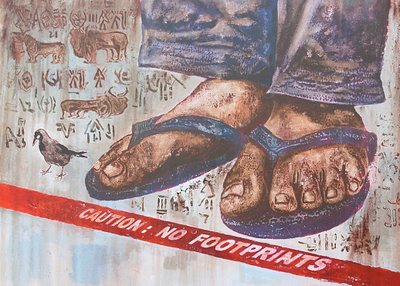 CROSSROAD
CROSSROAD
We next meet our Adam at the ‘Crossroad’. Obviously, the poor fellow hasn’t yet found his way out of the Socratic cave. Three millennia stuck in that place, and all he’s managed to get himself is a blue denim-jeans and a pair of bathroom-slippers. And what’s that? Our hero has found himself a new friend: observe, my dear, that tiny little Crow. No, its not part of the cave painting: after all, whoever heard of cavemen (and cavewomen) painting crows? He’s standing behind a thick red line that proclaims: CAUTION: NO FOOTPRINTS. Apparently, there’s no way he can walk out of here. So what does he do?
 TRAJECTORY
TRAJECTORY
With a little help from his friend- the crow, now perched precariously atop his head- he flies! His hands- extended backwards, palms tense, fingers stretched- have transformed into wings, and he’s high up there with the Wright-brothers’ invention. No, this can’t be true: after all, had God intended for Mammon to fly, He’d have given us wings? Everything is turned UPSIDE DOWN: in this tale, we’ve the WRONG BROTHERS instead. The paradox is reflected in the reemergence of cave painting-like human figures over the orange sky: they tell a parable in pictures, of a man who takes a leap, only to fall tumbling down. The only consolation is that he managed to land safely on the ground. Like the Zen acolyte- who leaves his house in search of his bull, and in the end returns empty-handed only to discover that it was never really lost- flying is something Adam’s got to do. But as Tushar- Adam- points out, “it’s not the man who flies, it’s the Crow!” Thus we leave the Crow to pursue his own unchartered Trajectory in the azure world.
 NAKED
NAKED
Adam, quite naturally, isn’t very happy about this last effort: after all, who likes to be made a fool off? Moreover, he’s been abandoned once again, this time by his friend, the Crow. In this painting entitled ‘Naked’, he’s gone out to look for him: fingers cupped around an open mouth, Adam’s calling out for the Crow. He’s angry at being deceived: look at the fist at the corner; its middle-finger is raised, signaling a rude ‘fuck-you’. He’s also pissed at being so foolish: ‘SHIT’.
 SALWA JUDUM
SALWA JUDUM
In the context of Chhattisgarh, this attitude finds manifestation in a new madness called 'Salwa Judum': an angry-terrified orphan-child juxtaposed against his parent's lifeless arm, a rope tied around its wrist, suggestive of the manner in which it met its end. Blood drips all over: an entire culture is washed out, erased.
Perhaps, the time has come to STOP and think things over. For new Beginnings? Behold, a Brave New World Beckons!
 PATANGBAAZ
PATANGBAAZ
In this last work entitled ‘Patangbaaz’ [lit: an ace kite-flyer], Adam- and the artist, Tushar- have finally found themselves: it is both a return, and a leap forward. They’re no longer lost: this is where the trajectory of their lives has brought them. No longer afraid to confront their Maker, they stand tall, and with crossed-arms, boldly look him in the eye. He- the Maker- too is no longer angry, as in the first two paintings. The background, this time, isn’t menacing: it is white, like Locke’s Tabula Rasa: a blank slate waiting to be filled. And of course, Adam flies. No, not himself. His kites do!
AJ
Read More (आगे और पढ़ें)......
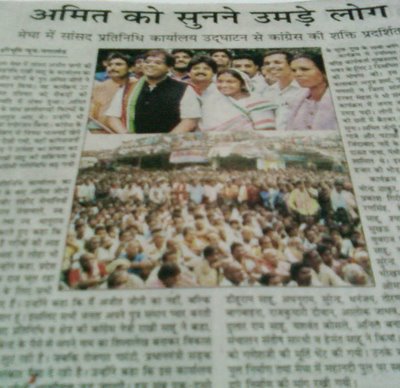 Haribhoomi (28.8.06)
Haribhoomi (28.8.06)




